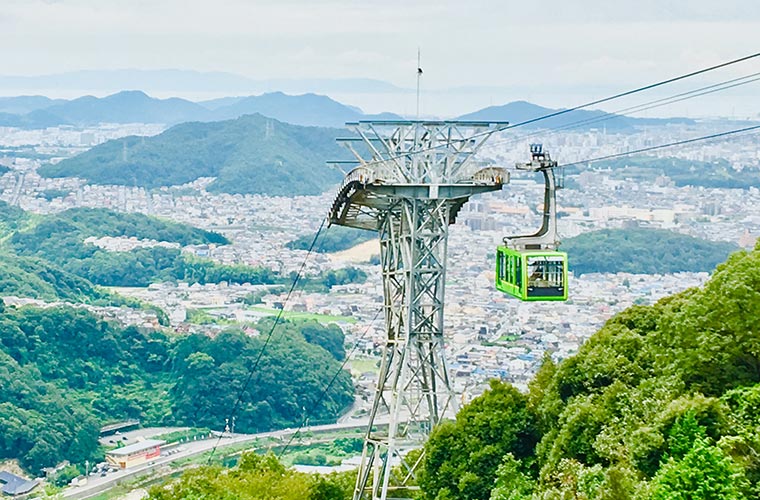
Jan 24, 2024 617 views
Shoshazan Engyoji Temple – Location of Movie “The Last Samurai” |View of autumn leaves from Ropeway and experience sitting meditation, etc
Shoshazan Engyoji Temple is located on Mount Shosha in Himeji City. Especially during the fall foliage season (November), the entire mountain turns red, yellow, and orange, attracting many tourists. Visitors can also experience some of the monks’ ascetic practices, such as zazen and sutra copying. Why not take a short trip from Himeji City and spend some time to calm your spirit?
INDEX
- ・How to get to Shoshazan Engyoji Temple
- ・Important cultural properties located 371m above sea level
- ・Famous as a filming location for the movie “The Last Samurai”
- ・Experience vegetarian cuisine, zazen, and sutra chanting
- ・“Momiji Festival” is held in mid-November
- ・Goshuin
- ・Souvenirs and Restaurants
- ■Information
・How to get to Shoshazan Engyoji Temple
1) Take the Shinki Bus bound for Shoshazan Ropeway from JR Himeji Station to the last stop (approx. 30 minutes ride).
Ride fee:
Adult: 320 yen (one way)
Under 12 years old: 160 yen (one way)
2) Take the Shoshazan Ropeway from “Sanroku Station” to “Sanjo Station” (approx. 4 minutes ride). Time table >>
Ropeway Fare:
Ages 12 and over: 1,200 yen (round trip)
Ages 6 and over: 600 yen (round trip)

From JR Himeji Station to Mt. Shosha can be reached by car or bus. By bus, take Shinki Bus No. 8 “for Mt. Shoshazan Ropeway” from bus stop No. 10 at the north exit of Himeji Station. It takes about 30 minutes to get to the last stop, the Shoshazan Ropeway.
Most people take the ropeway from the foot of the mountain to the top. From the bus stop, walk west along the elevated highway for about one minute to reach the building where the ropeway entrance is located. The ropeway runs four times an hour and takes about four minutes to reach the summit.
At the Shinki Bus Himeji Station Information Center located at Himeji Station, you can purchase a special ticket that includes both the bus and ropeway.
Special Ticket:
regular adult round-trip ticket: 1,700 yen
child round-trip ticket: 850 yen More info >>
*The ropeway is closed from January 20 (Mon.) to March 23 (Sun.), 2025 for scheduled maintenance.
・Important cultural properties located 371m above sea level
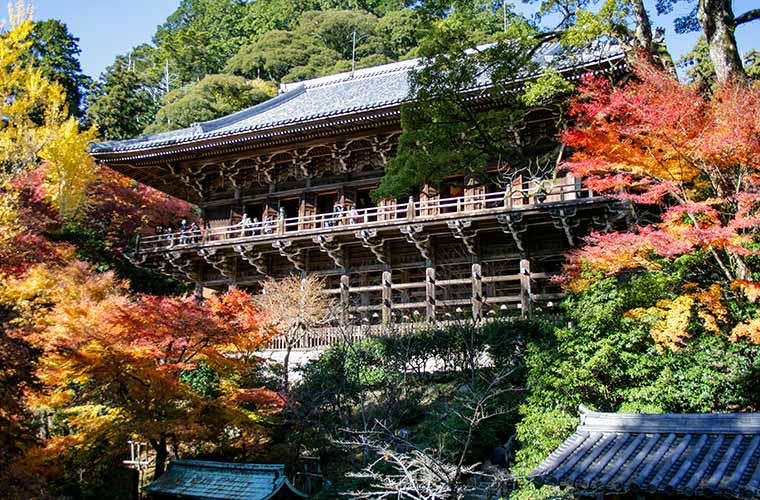
Shoshazan Engyoji Temple is located on Mount Shosha, a 371-meter-high mountain in Himeji City. Many historical buildings constructed approximately 600 years ago remain on the site. There are nine National Important Cultural Properties in the buildings alone. Map for Shoshazan Engyoji Temple >>
Around the temple are trees, moss, and rocks that are several hundred years old, allowing visitors to feel the power of nature all around them. Especially in the fall, the entire mountain turns red and many tourists visit to see the beautiful autumn leaves.
This is a recommended sightseeing spot to visit when you visit Himeji, and is also popular among foreigners.
Recommended Route
Shoshazan Engyoji Temple has a lot of things worth seeing. Most visitors go to see the main hall, “Maniden,” which is located in the center of the temple.
From the ropeway station to Mani-den, the entrance to Engyoji Temple, is about 1 km, a 15-20 minute walk. Wear comfortable walking shoes and clothing. A microbus (500 yen) runs from in front of Shinosho* to the bottom of Mani-den.
*Shinosho…In Japanese shrines, the entrance fee to a temple is called “shinokin”. The place to pay this fee is called “shinosho”.
Maniden is the main hall at the center of Engyoji Temple. It is built in the “Butai-zukuri” architectural style, in which the floor is constructed with lattice-like pillars and the building is built on top of the pillars, in places where there is a large difference in elevation, such as in the mountains. Kiyomizu-dera Temple in Kyoto is famous in Japan. Looking up from below, the pillars stand in neat rows, overwhelming the viewer.
Visitors can enter the “Maniden” by going up the stairs. It is good manners to take off your shoes before entering. Inside, buy candles and incense sticks and pay homage to the Buddha.
Another Recommended Route(2 to 3 hours)
The Mani Hall alone is worth seeing, but if you have time, take a walk around the buildings of historical value that are scattered throughout the grounds.
You can enter the “Maniden” , the “Jikido” where you can experience sutra copying, and the ” Okunoin (Kaizando),” a nationally designated important cultural property. Feel the weight of history and the grandeur of nature.
Example: Ropeway station – 20 min. on foot – Mani-den Hall – 5 min. on foot – San-no-do Hall (Main Lecture Hall, Restaurant, Jogyo-do Hall) – 1 min. on foot – Okuno-in Hall (Kaisan-do Hall) – 30 min. on foot (30 min. on foot)- ropeway Mt.
How to worship
1) Bow once in front of the main hall.
2) Make a donation** to the donation box. Do not throw the money, but gently put it in.
3) Hold the rope and ring the waniguchi***.
4) Close your eyes and clasp your hands together in front of your chest.
5) Bow once with joined hands.
**Saisen…Money paid to shrines and temples as a token of gratitude. There is no fixed amount.
***Waniguchi … A kind of Buddhist ritual utensil used by worshippers to pray for the fulfillment of various wishes.
・Famous as a filming location for the movie “The Last Samurai”
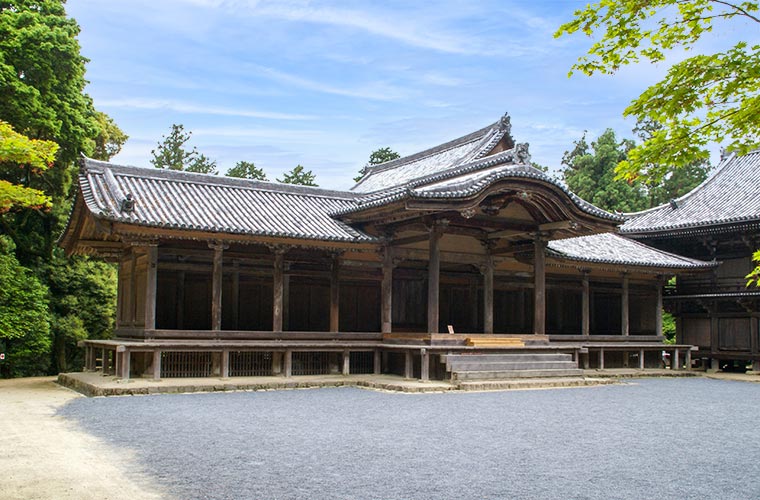
Many important cultural properties remain within the spacious grounds, which have also been used as filming locations for movies. “The Last Samurai,” a Hollywood movie depicting the spirit of bushido, was famously filmed here. Jogyo-do where monks practiced walking while chanting the name of Amitabha Buddha was used for the filming.
Upon entering the site, one is overwhelmed by the magnificent world view of the fusion of nature and historical buildings. Just being in this place should sharpen your senses.
・Experience vegetarian cuisine, zazen, and sutra chanting
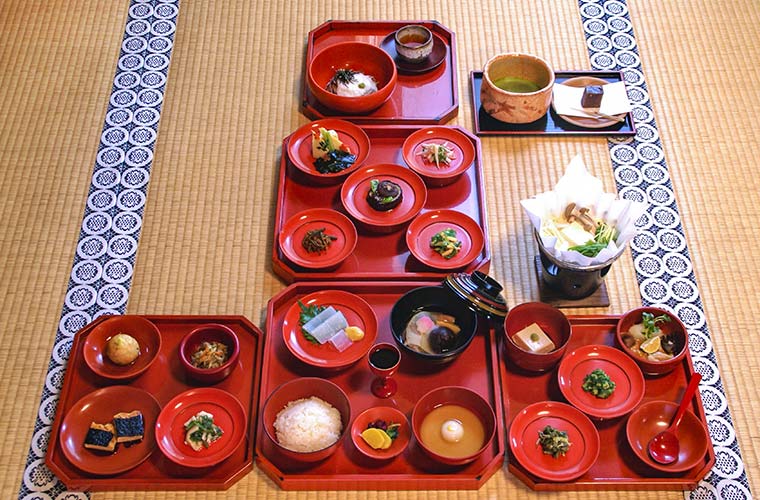 *Available from April to the end of November. Reservation required; minimum of 5 people.
*Available from April to the end of November. Reservation required; minimum of 5 people.
At Juryouin, a National Important Cultural Property, you can enjoy vegetarian honzen cuisine* (15,000 yen) prepared according to the traditional menu of Engyoji Temple. The dishes are served in traditional red and black lacquerware called “Shokuran-nuri”.
*Shojin ryori is a type of vegetarian cuisine that does not contain animal products such as meat, fish, or eggs. Originally, it was a meal eaten by Buddhist monks during their ascetic training.
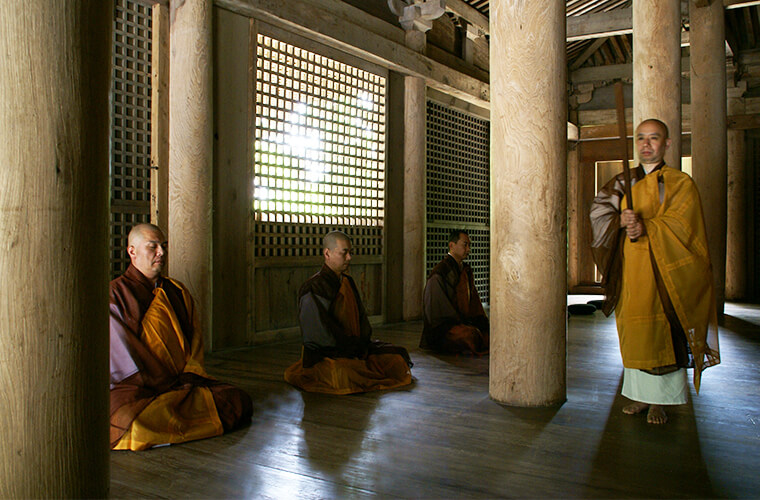
There are several programs available for those who wish to “Rokkonshojo” (purification of the six roots), which is believed to purify the eyes, ears, nose, tongue, body, and will (mind).
“Zazenkai” (free of charge, no reservation required) is held on the third Saturday of each month from 11:00 a.m. at Jogyodo. Shakyotaiken (10 minutes, from 300 yen, no reservation required) is also available at the Shokudo.
In both of these experiences, visitors sit in an upright posture and unify their minds to face themselves and experience the Buddhist way of practice. Even those who cannot sit on the floor are welcome. It is important to keep your back straight and calm your mind.
The “1-day shugyotaiken” (5,000 yen, reservation required), which allows you to experience both zazen and sutra copying, is offered once a month. Those who wish to try it should call to inquire.
*Zazen is a Buddhist practice in which one sits cross-legged in an upright posture to unify the mind.
**Shakyo is a method of Buddhist practice in which one transcribes Buddhist scriptures.
Note:
Zazen experience, Shakyo experience, and 1-day Shugyo experience must be accompanied by a Japanese-speaking person or a Japanese-speaking guide.
As of November 8, 2024, “Zazen-kai” cannot be reserved by individuals except on the third Saturday of each month. Group reservations are available upon request.
・“Momiji Festival” is held in mid-November

In autumn, the trees on Mt. Shosha turn red and yellow and the beautiful autumn leaves can be enjoyed to the fullest, and the annual “Momiji Festival” is held in mid-November. During the festival, valuable cultural properties such as Jumyo-do, Kongo-do, and Mani-den, which are usually closed to the public, are specially opened to the public.
Momij Festival: November 15 (Fri.) – 17 (Sun.), 2024 10:00 a.m. – 8:00 p.m.
Special Stage: November 16 (Sat.) from 4:30 p.m. (tentative)
*Japanese drum performance at San-no-do Plaza (free admission)
Light-up: Every day during the event term (5:00 p.m. – 8:00 p.m.)
・Goshuin
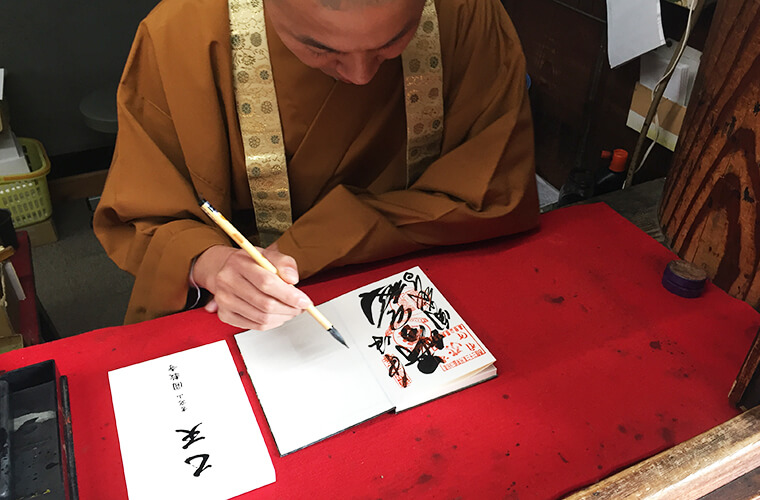
Do you know what a “Goshuin” (red seal) is? The name of the temple, the name of the principal image, and the date are written in a special ledger, and a stamp is placed on the ledger. This stamp means a record of your relationship with the gods and Buddha. Each shrine or temple has a different design. Collecting Goshuin stamps” is a popular activity in Japan.
At Engyoji Temple, visitors can obtain five types of red seals at the Mani Hall, the Jiki-do Restaurant, and the Kaizan-do Hall. The “Maniden” sells an original red seal book (ledger book), so it is recommended to purchase one to commemorate your visit.
*The ropeway is closed from January 20 (Mon.) to March 23 (Sun.), 2025 for scheduled maintenance. During this period, the ropeway will be open from a.m. 9:00 to p.m. 4:30 at the waiting area at the ropeway foot station, and red seals will be accepted.
・Souvenirs and Restaurants
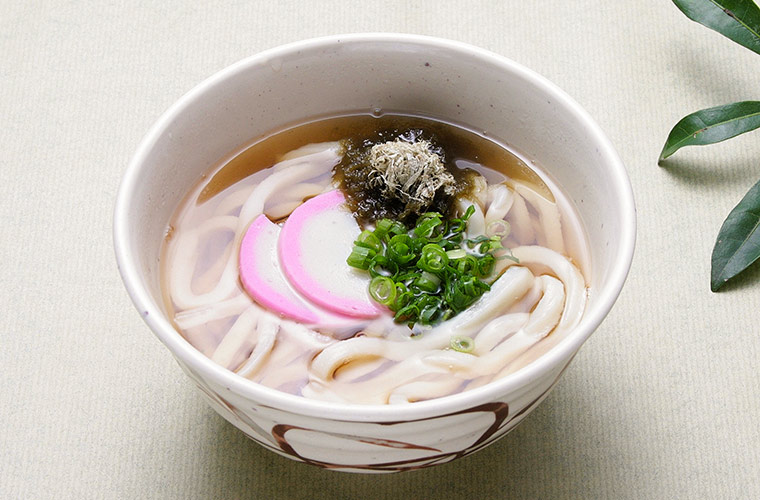
Udon 700 yen
The restaurant “Hazuki Tea House” located at the foot of Maniden offers a wide variety of easy-to-eat Japanese dishes. Udon, oden, onigiri, etc. are available.
The most popular dish is udon with dashi broth. The udon soup has a refreshing aftertaste that makes you want to drink every last drop.
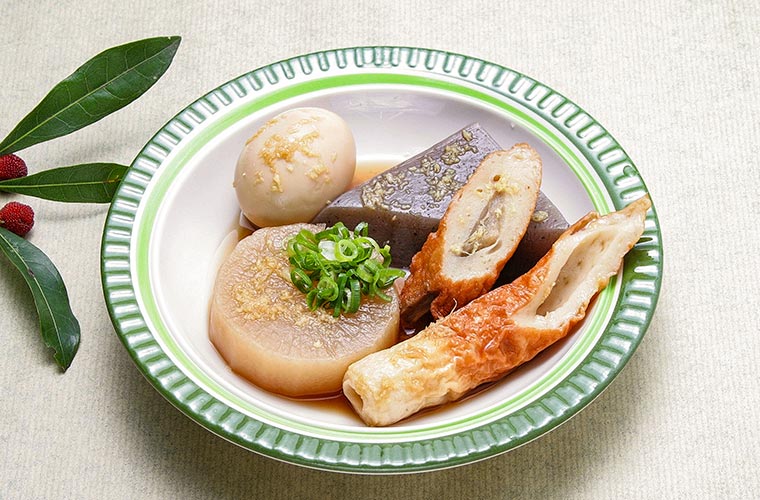
Oden 800 yen
Slowly simmered Oden warms up your body after a long walk in the cold season. After a day of strolling, warm up your body with Japanese fast food.
You can buy good luck charms at the Mani Hall. There are various types, and the most popular are the “Yume Kano Mamori” (dream come true) and the “Sakura Mamori” (cherry blossom protection) with a cherry blossom charm. You can buy one for yourself to wish for safe travels, but the charms in cute colors will also be appreciated as gifts.
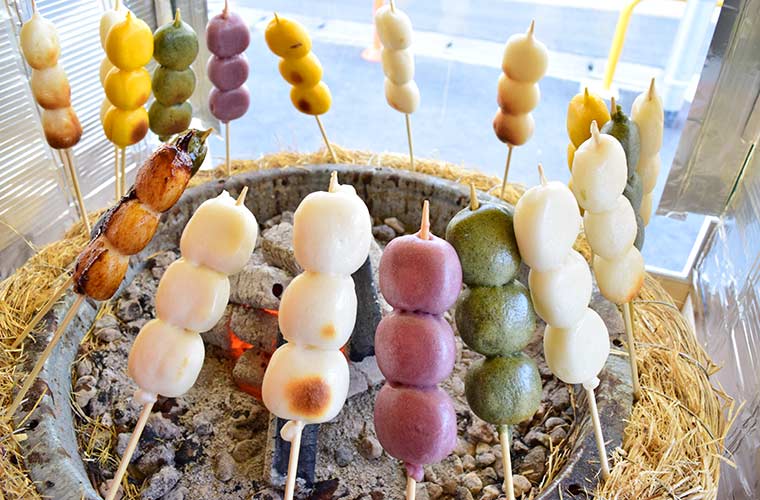
At the store in the parking lot of “Sanroku Station,” one skewer of the famous charcoal-grilled “Shosha Dango” (380 yen) is available for purchase.
The handmade dumplings come in three varieties: shiratama, mugwort and pumpkin.
You can have the dumplings topped with your choice of two types of sauce: soy sauce or miso.
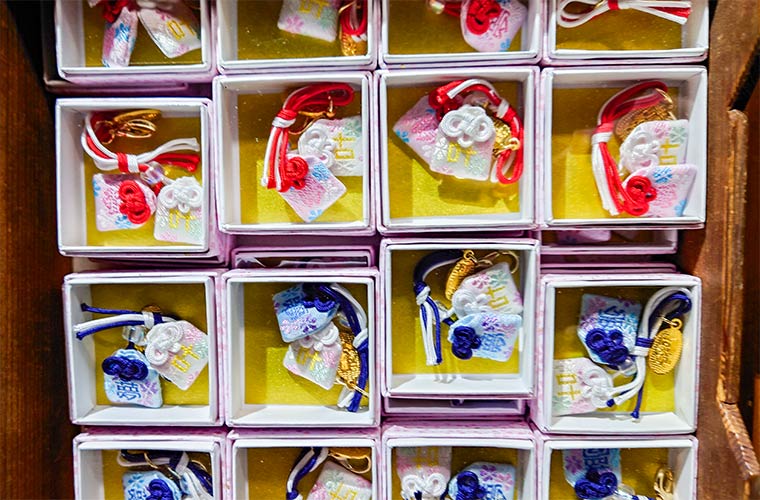
Maniden also sells cute good luck charms. Japanese lucky charms are said to ward off evil and bring grace of God. It is recommended to buy one for yourself or as a souvenir.
■Information
DATA
- Yes
- No
-
Wi-Fi

-
Toilet

-
locker

-
Restaurant

On-site -
Parking

-
foreign language

brochure
- Address
- 2968, Shosha, Himeji, Hyogo
- Business hours
- 9:00 a.m. - 5:00 p.m. (Admissions closed 4:30 p.m.)
- Regular holiday
- No holidays
TOP 5
-
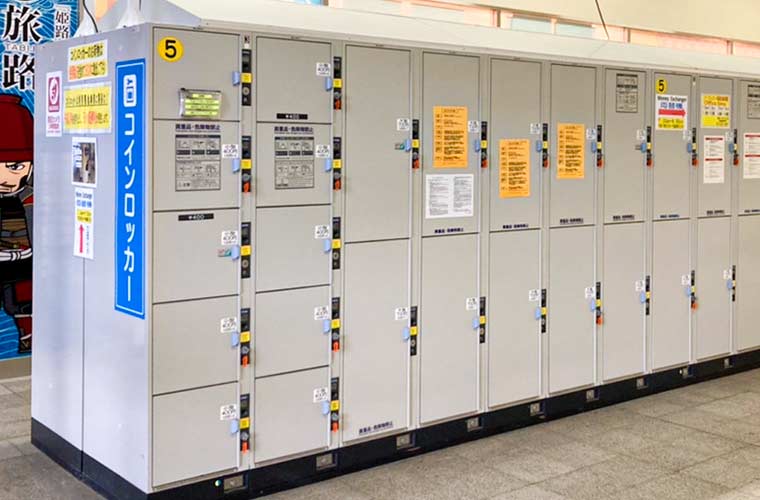 1
1
Useful Information
Where to Find Luggage Lockers & Storage Near Himeji Station|Cash & Card OK + Route Guide Video Included
-
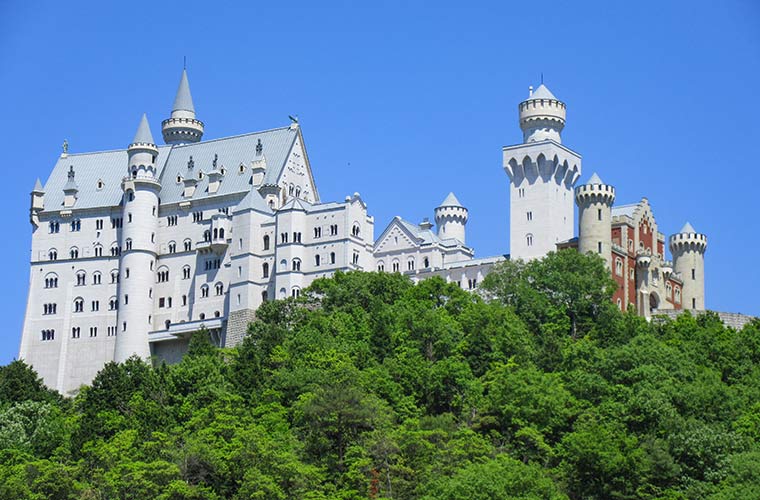 2
2
Things to Do in Himeji
TAIYO PARK - A theme park of World Heritage|Neuschwanstein Castle appears in the mountains of Himeji?
-
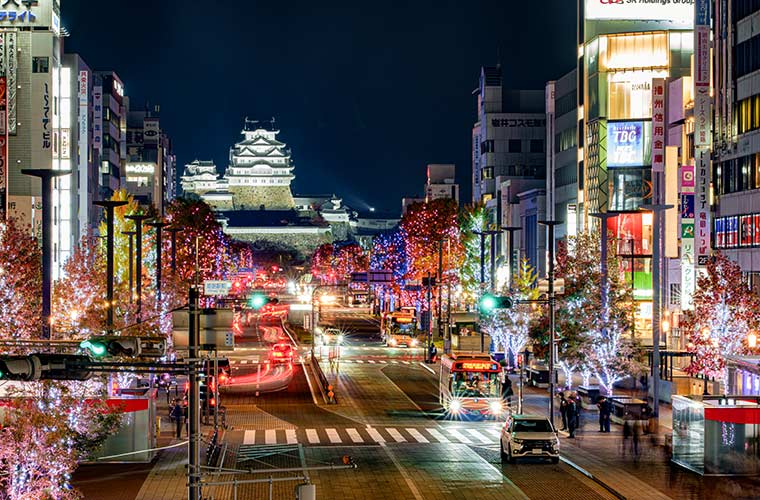 3
3
Himeji Castle
9 Best Places to See Himeji Castle|Get the perfect shoot with cherry blossoms or the replica of the killer whale, etc
-
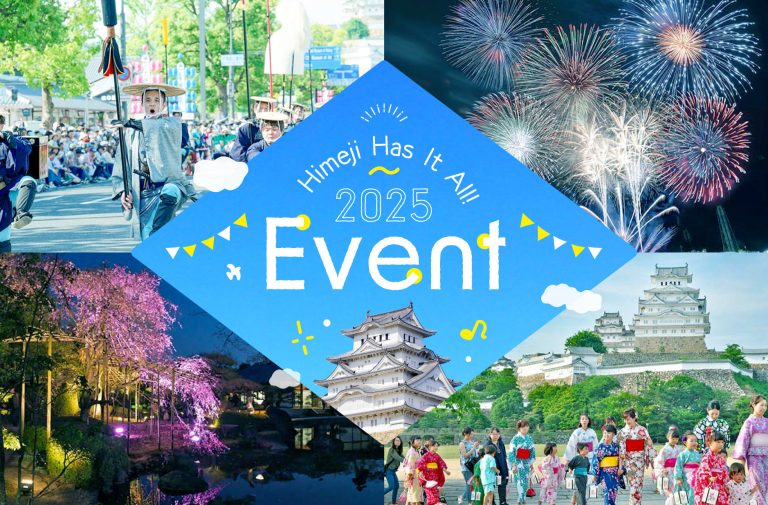 4
4
Things to Do in Himeji
Himeji City Events 2025|Discover Festivals & Events Near Himeji Castle!
-
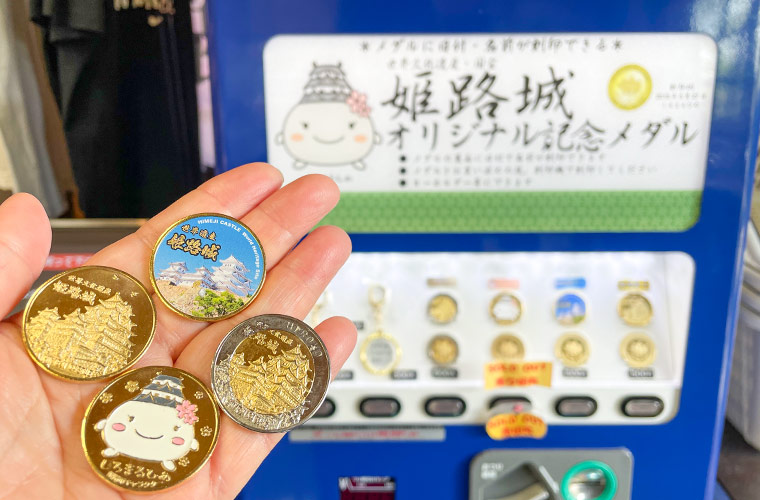 5
5
Himeji Castle
Keepsake of Himeji Castle|Why not collect the cool castle seal, medals, and stamps?






